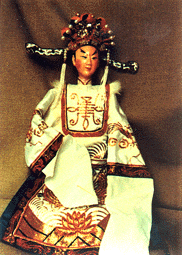Quanzhou string puppetry has 36 puppets comprising the sheng, dan, fing mo (minor male roles), and chou (clowns), as well as gods, spirits, tigers, and dogs. Quanzhou string puppet shows are all based on the written script, known popularly as kudeibu. The Simei String Puppet Troupe of Quanzhou has a rich repertoire of more than 500 plays including The Story of Yue Fei, Outlaws of the Marsh, Journey to the West, and the rare plays of Zhang Fei Makes His Escape, Han Xiangzi, and Creation of the Gods.
Puppetry is an art form that stresses the performance of the puppeteers. Throughout the history of puppetry, a number of gifted puppeteers have made a name for themselves.
In the last years of theQing Dynasty, Lin Chengchi and others from Quanzhou's Longban String Puppet Troupe were able to make their puppets do stunts such as sheathing and drawing a sword and opening anumbrella. Meanwhile, He Zhan of Quanzhou's Huban Puppet Troupe could make his character do four movements simultaneously: kicking a leg, pointing a finger, holding a scabbard, and rolling the eyeballs.
In modern times, a number of puppeteers have distinguished themselves with their superb art of manipulation and the design of movements of their puppets. Zhang Xiuyin was famous for his character Lady White in The White Snake, Xie Zhenxiang for his Wu Yuan in A Contest at Tongguan Pass, and Huang Yique for his young Buddhist novice in Flooding the JinshanTemple.
 Wire Puppets inChaozhou, Guangdong
Wire Puppets inChaozhou, Guangdong
 Wire puppetry now exists only in Guangdong's Chaozhou, Shantou Jieyang, and Yaoping, and is known as "papershadow" because it evolved from local shadow puppets. In the late Qing Dynasty, Chaozhou shadow play artists replaced flat figures cut from leather with rounded figures, each with a straw torso, paper mache hands, wooden legs, and a head molded from clay The fully clothed puppets had pieces of wire attached to their hands and backs to allow for manipulation. Following the example of the Guangdong opera stagecraft, puppeteers substituted the glass screen with a backdrop and used simple props such as chairs and tables on the stage. The demand for wire puppet shows increased along with the rise in religious activities.
Wire puppetry now exists only in Guangdong's Chaozhou, Shantou Jieyang, and Yaoping, and is known as "papershadow" because it evolved from local shadow puppets. In the late Qing Dynasty, Chaozhou shadow play artists replaced flat figures cut from leather with rounded figures, each with a straw torso, paper mache hands, wooden legs, and a head molded from clay The fully clothed puppets had pieces of wire attached to their hands and backs to allow for manipulation. Following the example of the Guangdong opera stagecraft, puppeteers substituted the glass screen with a backdrop and used simple props such as chairs and tables on the stage. The demand for wire puppet shows increased along with the rise in religious activities.
Dawu Township of Chaozhou has been famous for its wide variety of clay puppet heads. It has workshops scattered in the township, supplying puppet heads to customers in Guangdong and abroad.
Chaozhou wire puppets have increased in length from 12 to 16 inches, and the wires have been extended from one foot to 18 inches. The puppeteers either sit or stand on the stage. Each troupe consists of nine people -- three puppeteers, three singers, and three musicians. The stage, which is about 10 feet square, rises some five feet above the ground. The puppeteers sit behind the curtain.
